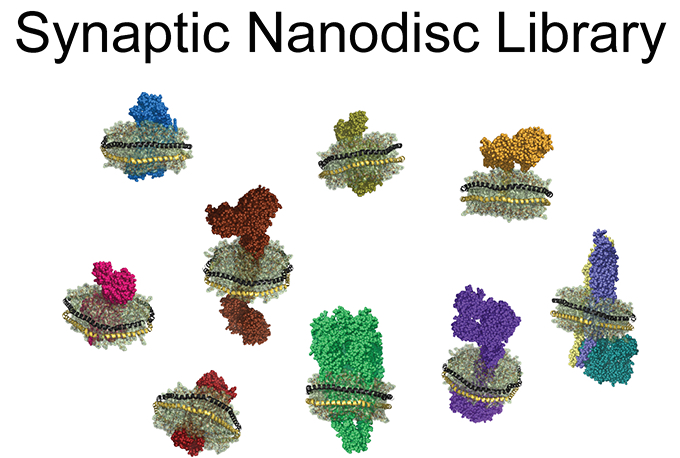May 8, 2015
Synaptic Membrane Nanodiscs May Help Find Alzheimer’s Disease Therapeutics
Congratulations to William Klein of NU for his recent publication in PLoS One: “Nanoscale Synaptic Membrane Mimetic Allows Unbiased High Throughput Screen that Targets Binding Sites for Alzheimer’s-Associated Aβ Oligomers.” Using a High Throughput Screening (HTS) facility at NU, Klein and colleagues developed a cell-free system consisting of a library of synaptic proteins individually embedded in nanoscale lipid bilayers (Nanodiscs). Nanodiscs proved successful in a pilot HTS screen for small molecule inhibitors of amyloid β oligomer (AβO) binding. This novel technique appears promising for future large-scale HTS screens for membrane protein targets, including potential Alzheimer’s disease therapeutics. The publication is attributed to a CBC HTS Supplemental Grant awarded to Klein in June 2013.
 Alzheimer’s disease (AD) affects about 6% of people over 65 years of age and causes close to half a million deaths each year. Currently, no treatment is available to prevent, stop or reverse the disease progression. Amyloid β oligomers (AβOs) are neurotoxic ligands that bind to synaptic proteins and instigate the synapse damage associated with AD. Identification of AβO-specific receptor(s) has been evasive due to extensive protein-protein interactions that occur following AβO binding to synaptic membranes and rapid internalization of the AβOs complexes. Thus, developing a simplified system that isolates the initial AβOs attachment step could facilitate identification of both the AβO-specific receptor(s) and potential small molecule therapeutics that block AβO-receptor interactions.
Alzheimer’s disease (AD) affects about 6% of people over 65 years of age and causes close to half a million deaths each year. Currently, no treatment is available to prevent, stop or reverse the disease progression. Amyloid β oligomers (AβOs) are neurotoxic ligands that bind to synaptic proteins and instigate the synapse damage associated with AD. Identification of AβO-specific receptor(s) has been evasive due to extensive protein-protein interactions that occur following AβO binding to synaptic membranes and rapid internalization of the AβOs complexes. Thus, developing a simplified system that isolates the initial AβOs attachment step could facilitate identification of both the AβO-specific receptor(s) and potential small molecule therapeutics that block AβO-receptor interactions.
In the paper published on April 30, 2015 in the journal PLoS One, titled “Nanoscale Synaptic Membrane Mimetic Allows Unbiased High Throughput Screen that Targets Binding Sites for Alzheimer’s-Associated Aβ Oligomers,” William Klein, Professor of Neurobiology at NU (right), and his colleagues constructed a solubilized membrane protein library (SMPL) containing individual synaptic membrane proteins incorporated into nanoscale self-assembling phospholipid bilayers called Nanodiscs (see schematic below). The binding of AβOs to Nanodiscs mimics AβO binding to synaptic membranes both intact and fragmented (synaptosomes). As Nanodiscs are soluble they can be used in solution-based HTS assays. In a pilot HTS screen of 2700 drug-like compounds, several candidates blocked AβO binding to Nanodiscs, but only one, aurin tricarboxylic acid (ATA), inhibited AβO binding to both Nanodiscs, synaptosomes, and neurons. Although ATA is not a therapeutic candidate, it will be a useful experimental antagonist for future mechanistic studies of AβOs in AD models.
 These results provide proof of concept for using SMPL-Nanodiscs in HTS assays for AβO receptor(s) and binding antagonists. The reported work stems from collaboration between Klein’s lab, notably Kyle Wilcox, postdoctoral fellow in the lab and the first author on the paper, and Stephen Sligar, inventor of Nanodiscs and director, School of Molecular and Cell Biology, UIUC. HTS experiments were carried at the NU High Throughput Analysis Laboratory (HTA) directed by Chi-Hao Luan, also co-author on the paper. The publication is partially attributed to the CBC HTS Grant awarded to Klein in June 2013 for a project titled: “Biomimetic Nanodiscs for HTS discovery of AβO binding antagonists.”
These results provide proof of concept for using SMPL-Nanodiscs in HTS assays for AβO receptor(s) and binding antagonists. The reported work stems from collaboration between Klein’s lab, notably Kyle Wilcox, postdoctoral fellow in the lab and the first author on the paper, and Stephen Sligar, inventor of Nanodiscs and director, School of Molecular and Cell Biology, UIUC. HTS experiments were carried at the NU High Throughput Analysis Laboratory (HTA) directed by Chi-Hao Luan, also co-author on the paper. The publication is partially attributed to the CBC HTS Grant awarded to Klein in June 2013 for a project titled: “Biomimetic Nanodiscs for HTS discovery of AβO binding antagonists.”
Established in Spring 2013, the CBC HTS Supplemental Grant program was designed to support pilot projects focused on biomedically-relevant targets that will be conducted at a HTS core facility located at one of the CBC universities. The three HTS facilities include the aforementioned NU HTA, the University of Chicago’s Cellular Screening Center (CSC), directed by Sam Bettis and The University of Illinois at Chicago (UIC) HTS Facility, with Kiira Ratia as director. The HTS directors play a crucial role in the HTS Award program. Applicants must have their screening assay approved by the HTS director of the facility they will be using prior to submitting an application to the CBC. If funded, the HTS director monitors the project’s progress and provides advice as needed to ensure the successful completion of the proposed work.
Funding: This work was supported by National Institutes of Health grants AG029460, AG022547, AG041953, GM33775, AG020506, AG039171; National Science Foundation grant EEC-0647560, and The Alzheimer’s Association Zenith Award ZEN-09-133875. Additional funding was provided by the Chicago Biomedical Consortium with support from the Searle Funds at The Chicago Community Trust.
CBC HTS Award (2013): Biomimetic Nanodiscs for HTS discovery of AβO binding antagonists; Project PI: William Klein (NU)
Publication attributed to the CBC HTS Award: Wilcox KC, Marunde MR, Das A, Velasco PT, Kuhns BD, Marty MT, Jiang H, Luan CH, Sligar SG, Klein WL. Nanoscale Synaptic Membrane Mimetic Allows Unbiased High Throughput Screen That Targets Binding Sites for Alzheimer’s-Associated Aβ Oligomers. PLoS One. 2015 Apr 30;10(4):e0125263. eCollection 2015. (PubMed)
Image credit: Schematic of Nanodiscs Library adapted from Wilcox KC, Marunde MR, Das A et. al. (PubMed)
see also:
